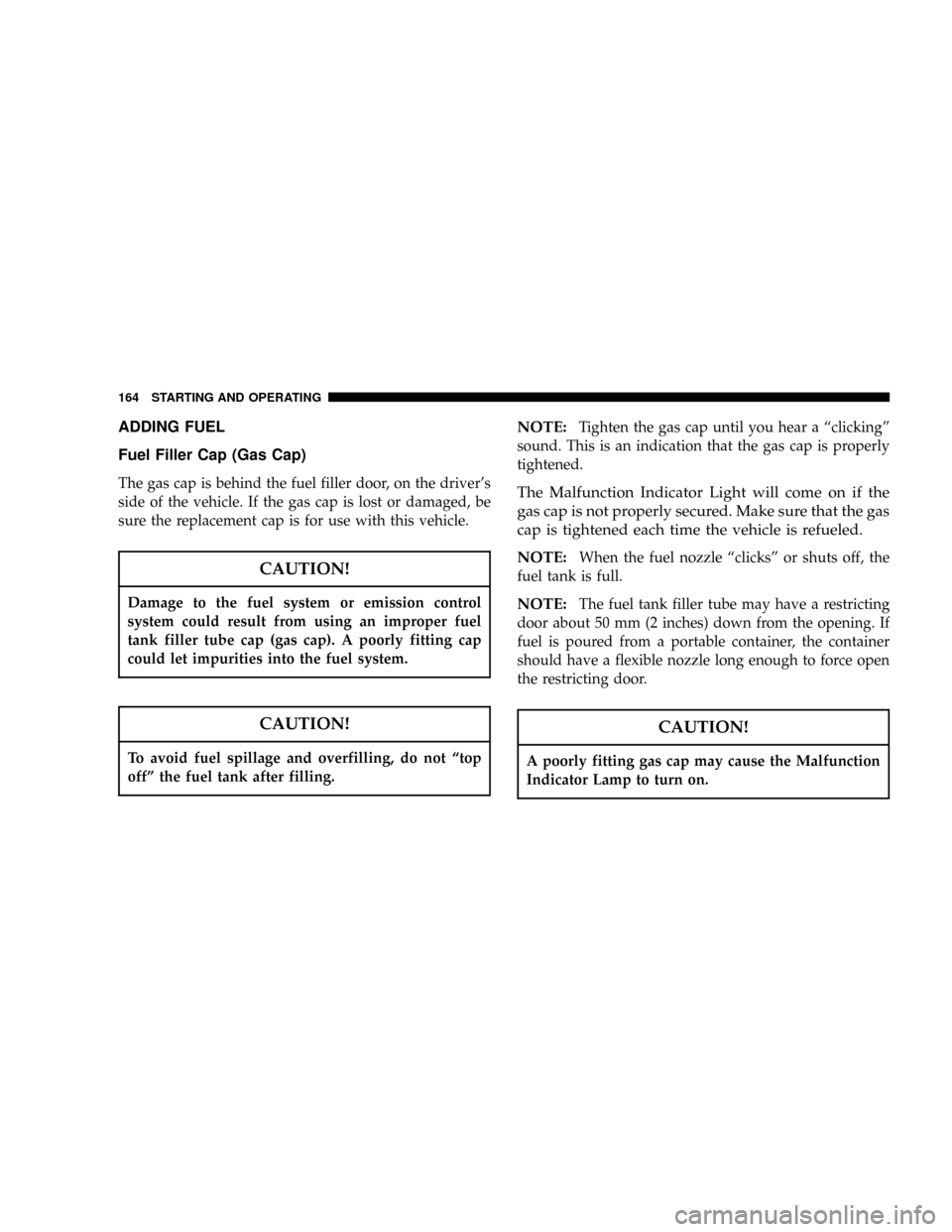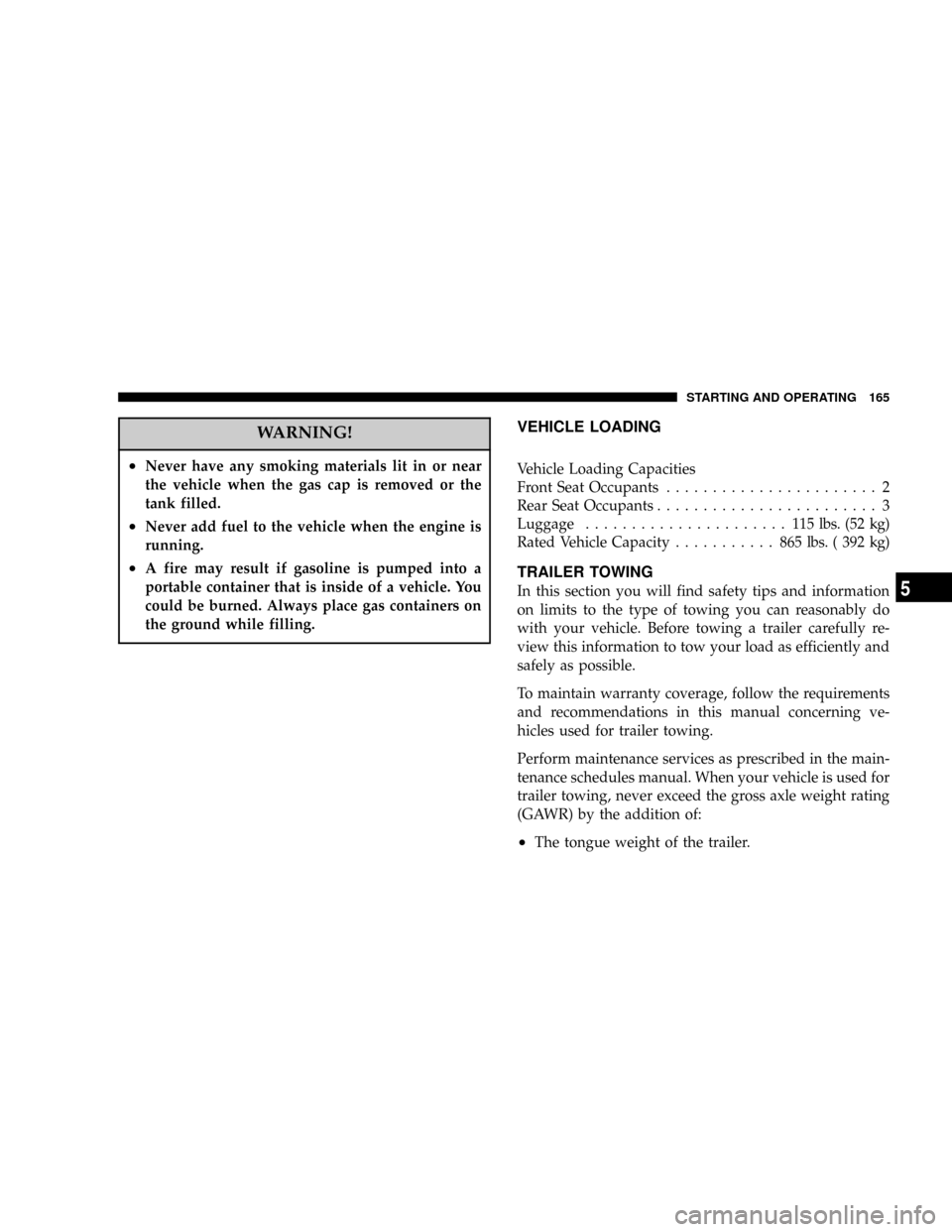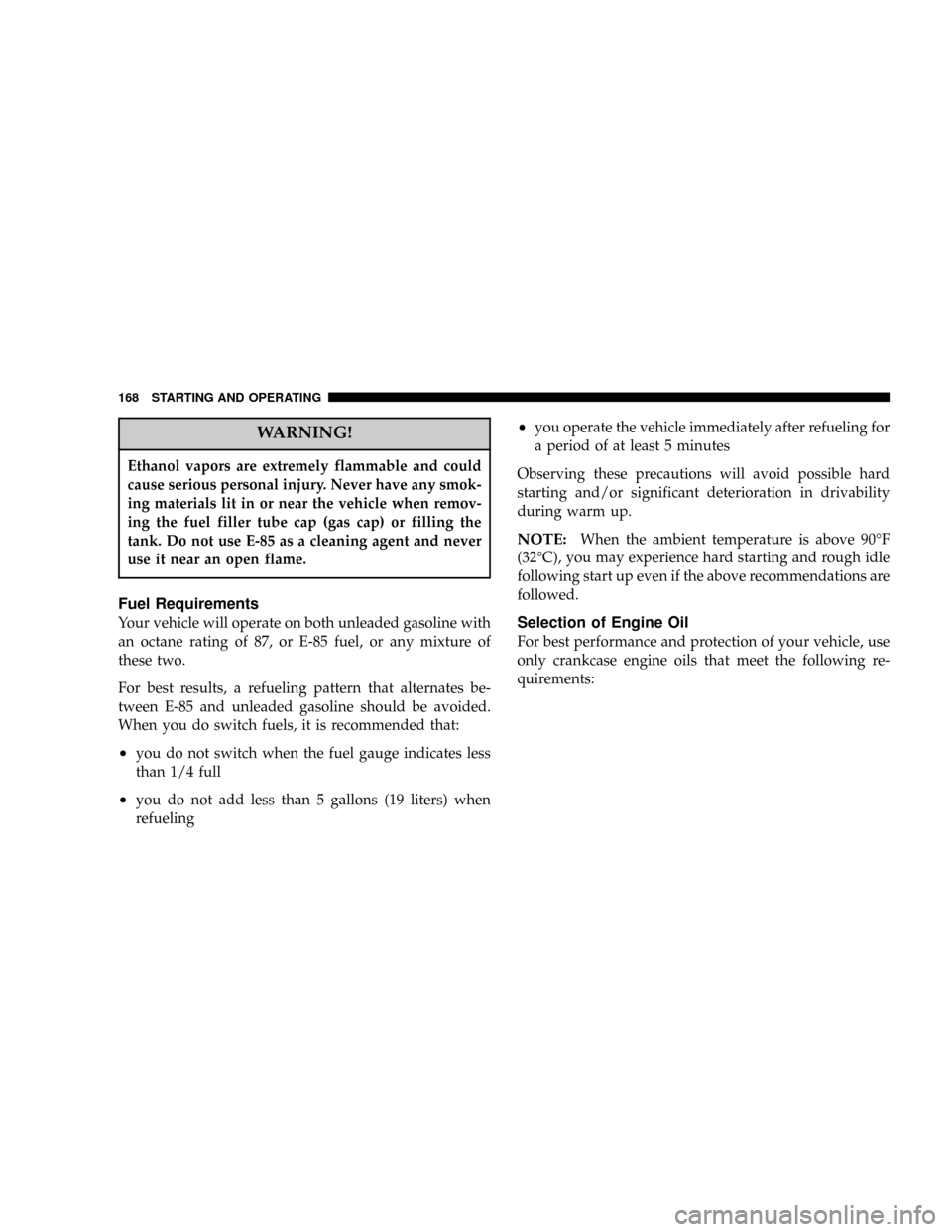2004 CHRYSLER SEBRING fuel cap
[x] Cancel search: fuel capPage 87 of 273

5. Tachometer
The red area of the scale shows the maximum permissible
engine revolutions-per-minute (rpm x 1000) for each gear
range. Before reaching the red area (over 6,500 rpm), ease
up on the accelerator to prevent engine over speed.
6. Turn Signal Indicators
The arrows will flash in unison with the exterior turn
signal, when using the turn signal lever.
7. High Beam Indicator
This light shows that the headlights are on high
beam. Pull the turn signal lever toward the
steering wheel to switch the headlights from high or
low beam.
8. Speedometer
Shows the vehicle speed in miles-per-hour and
kilometers-per-hour.
9. Charging System Light
This light shows the status of the electrical
charging system. The light should come on
briefly when the ignition is first turned on and remain
on briefly as a bulb check. If the light stays on orcomes on while driving, turn off some of the vehicle's
electrical devices, such as the Fog Lights or Rear
Defroster. If the Charging System Light remains on, it
means that the vehicle is experiencing a problem with
the charging system. Obtain SERVICE IMMEDI-
ATELY. See your local authorized dealer.
10. Malfunction Indicator Light
This light is part of an onboard diagnostic
system called OBD that monitors engine and
automatic transmission control systems. The
light will illuminate as long as the key is in the ON
position, prior to engine start up. Approximately 15
seconds later the MIL may blink for 10 seconds then
resume to full illumination. (See ªEMISSIONS IN-
SPECTION AND MAINTENANCE PROGRAMSº in
the ªMAINTAINING YOUR VEHICLEº section of
your Owner Manual for more details). If the bulb does
not come on when turning the key from OFF to ON,
have the condition checked promptly.
Certain conditions such as a loose or missing gas cap or
poor fuel quality may illuminate the light after engine
start. The vehicle should be serviced if the light stays on
UNDERSTANDING YOUR INSTRUMENT PANEL 87
4
Page 130 of 273

mTire Safety Information..................144
NTire Markings........................144
NTire Identification Number (TIN)..........147
NTire Loading And Tire Pressure...........148
mTiresÐGeneral Information...............151
NTire Pressure.........................151
NTire Inflation Pressures.................152
NRadial-Ply Tires......................154
NCompact Spare Tire Ð If Equipped.........154
NTire Spinning........................155
NTread Wear Indicators..................156
NReplacement Tires.....................156
NAlignment And Balance.................157
mTire Chains...........................158
mSnow Tires...........................158
mTire Rotation Recommendations...........158
mAutoStick Ð If Equipped................159
NAutoStick Operation...................160
NAutoStick General Information............160
mFuel Requirements.....................161
NReformulated Gasoline.................161
NGasoline/Oxygenate Blends..............162
NMMT In Gasoline.....................162
NSulfur In Gasoline.....................163
NMaterials Added To Fuel................163
mAdding Fuel..........................164
NFuel Filler Cap (Gas Cap)...............164
mVehicle Loading.......................165
mTrailer Towing........................165
NWarranty Requirements.................166
mFlexible Fuel ± (2.7L Engines With Automatic
Transmission Only)
.....................167
130 STARTING AND OPERATING
Page 164 of 273

ADDING FUEL
Fuel Filler Cap (Gas Cap)
The gas cap is behind the fuel filler door, on the driver's
side of the vehicle. If the gas cap is lost or damaged, be
sure the replacement cap is for use with this vehicle.
CAUTION!
Damage to the fuel system or emission control
system could result from using an improper fuel
tank filler tube cap (gas cap). A poorly fitting cap
could let impurities into the fuel system.
CAUTION!
To avoid fuel spillage and overfilling, do not ªtop
offº the fuel tank after filling.
NOTE:Tighten the gas cap until you hear a ªclickingº
sound. This is an indication that the gas cap is properly
tightened.
The Malfunction Indicator Light will come on if the
gas cap is not properly secured. Make sure that the gas
cap is tightened each time the vehicle is refueled.
NOTE:
When the fuel nozzle ªclicksº or shuts off, the
fuel tank is full.
NOTE:The fuel tank filler tube may have a restricting
door about 50 mm (2 inches) down from the opening. If
fuel is poured from a portable container, the container
should have a flexible nozzle long enough to force open
the restricting door.
CAUTION!
A poorly fitting gas cap may cause the Malfunction
Indicator Lamp to turn on.
164 STARTING AND OPERATING
Page 165 of 273

WARNING!
²Never have any smoking materials lit in or near
the vehicle when the gas cap is removed or the
tank filled.
²Never add fuel to the vehicle when the engine is
running.
²A fire may result if gasoline is pumped into a
portable container that is inside of a vehicle. You
could be burned. Always place gas containers on
the ground while filling.
VEHICLE LOADING
Vehicle Loading Capacities
Front Seat Occupants....................... 2
Rear Seat Occupants........................ 3
Luggage...................... 115lbs. (52 kg)
Rated Vehicle Capacity........... 865lbs. ( 392 kg)
TRAILER TOWING
In this section you will find safety tips and information
on limits to the type of towing you can reasonably do
with your vehicle. Before towing a trailer carefully re-
view this information to tow your load as efficiently and
safely as possible.
To maintain warranty coverage, follow the requirements
and recommendations in this manual concerning ve-
hicles used for trailer towing.
Perform maintenance services as prescribed in the main-
tenance schedules manual. When your vehicle is used for
trailer towing, never exceed the gross axle weight rating
(GAWR) by the addition of:
²The tongue weight of the trailer.
STARTING AND OPERATING 165
5
Page 168 of 273

WARNING!
Ethanol vapors are extremely flammable and could
cause serious personal injury. Never have any smok-
ing materials lit in or near the vehicle when remov-
ing the fuel filler tube cap (gas cap) or filling the
tank. Do not use E-85 as a cleaning agent and never
use it near an open flame.
Fuel Requirements
Your vehicle will operate on both unleaded gasoline with
an octane rating of 87, or E-85 fuel, or any mixture of
these two.
For best results, a refueling pattern that alternates be-
tween E-85 and unleaded gasoline should be avoided.
When you do switch fuels, it is recommended that:
²you do not switch when the fuel gauge indicates less
than 1/4 full
²you do not add less than 5 gallons (19 liters) when
refueling
²you operate the vehicle immediately after refueling for
a period of at least 5 minutes
Observing these precautions will avoid possible hard
starting and/or significant deterioration in drivability
during warm up.
NOTE:When the ambient temperature is above 90ÉF
(32ÉC), you may experience hard starting and rough idle
following start up even if the above recommendations are
followed.
Selection of Engine Oil
For best performance and protection of your vehicle, use
only crankcase engine oils that meet the following re-
quirements:
168 STARTING AND OPERATING
Page 227 of 273

License Plate Bulb Replacement
1. Locate both small slots on the outboard side of the
license lamp. Using a small screwdriver, remove the
entire housing.
2. Turn the bulb socket counterclockwise to remove it
from the housing. Pull the bulb out of the socket. Replace
the bulb and snap it back into place on the housing of the
chrome appliqu×.
Headlight Aiming
The headlights on your new vehicle were aimed at the
factory. The factory setting was made at a no load setting.
A great increase in weight will change the aiming and it
may be necessary to readjust the headlights if carrying an
excessive amount of weight in the trunk, rear seats or
pulling a trailer. To readjust the headlights first mark the
position of the headlights on a wall prior to loading the
vehicle. Load the vehicle and then readjust the headlights
to the original position. If any further adjustments are
necessary contact your manufacturer's dealer. A detailed
service procedure is contained in the manufacturer's
Service Manual. Information on purchasing a Service
Manual can be found at the back of this Owner's Manual.
FLUIDS AND CAPACITIES
U.S. Metric
Fuel (Approximate)
2.4 Liter Engine (87 Octane) 16 Gal-
lons61 Liters
2.7 Liter Engine (87 Octane) 16 Gal-
lons61 Liters
Engine Oil-with filter
2.4 Liter Engines (SAE 5W-30) 5 qts. 4.7 Liters
2.7 Liter Engines (SAE 5W-30) 5 qts. 4.7 Liters
Cooling System *
2.4 Liter Engines* (Mopart
Antifreeze/Coolant 5 Year/
100,000 Mile Formula)8 qts. 7.5 Liters
2.7 Liter Engines (Mopart
Antifreeze/Coolant 5 Year/
100,000 Mile Formula)9.5 qts. 9.0 Liters
* Includes 1 qt. for coolant tank.
MAINTAINING YOUR VEHICLE 227
7
Page 262 of 273

About Your Brakes...................... 141
Adding Engine Coolant (Antifreeze)......... 206
Adding Fuel.......................... 164
Aiming Headlights...................... 227
Air Cleaner, Engine..................... 196
Air Conditioning....................... 121
Air Conditioning, Operating Tips........... 126
Air Conditioning Refrigerant.............. 200
Air Conditioning System..............121,199
Air Pressure, Tires...................... 152
Airbag................................ 32
Airbag Deployment....................35,36
Airbag Light.....................36,39,48,86
Airbag Maintenance...................... 38
Airbag, Side........................... 37
Airbag, Window......................32,37
Alarm Light............................ 91
Alarm, Panic........................... 20
Alarm System.......................... 22
Alignment and Balance.................. 157
Alterations/Modifications, Vehicle............ 7
Antifreeze Disposal..................... 207
Antifreeze (Engine Coolant)............... 206Capacities........................... 227
Anti-Lock Brake System.................. 141
Anti-Lock Warning Light.................. 89
Anti-Theft Security Alarm................. 22
Appearance Care....................... 214
Automatic Door Locks.................... 16
Automatic Transaxle..................135,211
Filter.............................. 213
Fluid and Filter Changes................ 213
Fluid Level Check..................... 212
Interlock System....................12,136
Reset Mode......................... 137
Selection Of Lubricant................. 212
Shifting............................ 137
Special Additives..................... 213
Autostick............................. 159
Auxiliary Power Outlet................... 77
Ball Joints............................ 201
Battery............................... 198
Emergency Starting.................... 179
Gas Caution......................181,199
Heater............................. 134
262 INDEX
Page 265 of 273

Driving
On Slippery Surfaces.................. 182
Electrical Outlet, Auxiliary................. 77
Electronic Speed Control.................. 68
Emergency, In Case of
Jacking............................. 174
Emergency Trunk Release...............23,24
Emission Control System Maintenance....190,232
Engine............................187,188
Block Heater......................... 134
Break-In Recommendations............... 47
Checking Oil Level.................... 192
Compartment.....................187,188
Cooling............................ 205
Oil .............................192,227
Oil Change Interval................... 193
Oil Selection......................... 194
Oil Synthetic......................... 195
Overheating......................... 172
Partial Zero Emissions Vehicle for 2.4 Liter . . 232
Timing Belt.......................... 198
Engine Oil Viscosity..................194,227Engine Oil Viscosity Chart................ 194
Entry System, Illuminated................. 14
Exhaust Gas Caution.................... 204
Exhaust System........................ 204
Exterior Light Service.................... 222
Filters
Air Cleaner.......................... 196
Automatic Transaxle................... 213
Engine Fuel......................... 196
Engine Oil.......................... 195
Flashers
Hazard Warning...................... 172
Flexible Fuel Vehicles
Cruising Range....................... 170
Engine Oil.......................... 194
Maintenance......................... 170
Replacement Parts.................... 170
Starting............................ 170
Floor Console.......................... 53
Fluid Capacities........................ 227
Fluid Leaks............................ 49
INDEX 265
10